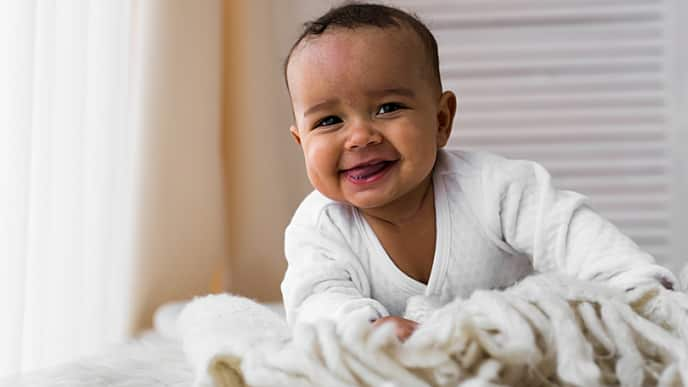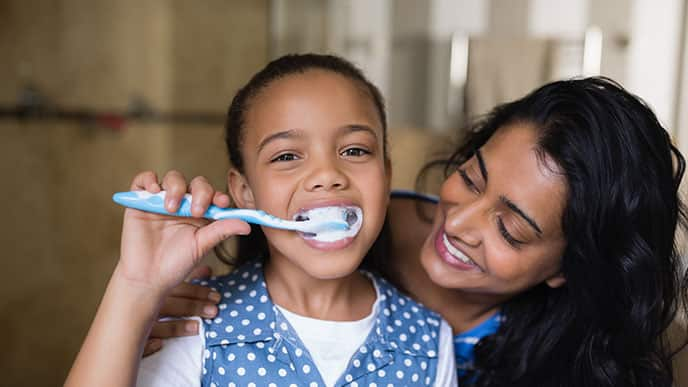What is Teething?
Teething is the process by which a baby's first teeth sequentially erupt through the gumline. Humans develop two sets of teeth during their lifetime: milk teeth and permanent teeth. The first set of teeth that erupt are the primary teeth, also called the milk or baby teeth, which are temporary. Permanent or secondary teeth erupt after the milk teeth fall out.
When Do Babies Start Teething?
The age when teething starts and the teething symptoms may differ among babies. Teething may begin as early as 3 months of age or as late as 1 year in some babies. Rarely, a baby is born with the first tooth. However, your baby will likely have the front teeth appear anytime during the first year.
While 6 months is the most common baby teething age, it can continue up to three years until the baby has a set of 20 milk teeth, 10 each in the upper and lower jaws. The Indian Dental Association provides a detailed tooth eruption chart for reference. Following the eruption of the first tooth, visiting a dentist within six months is important.
Teething Symptoms
Baby teething symptoms may vary from child to child. Some babies may feel pain and tenderness that lasts for several weeks, while others may exhibit different symptoms. So, how can you be sure if your baby is teething? The following are the various symptoms you may look for if you suspect your baby is teething:
- Gnawing or chewing hard things:
While babies usually love to put things in their mouths, biting or chewing on hard objects and rubbing things on their tender gums may become excessive when the teething begins. - Drooling:
Usually, a baby starts to drool before teething begins. Excessive drooling soaks the clothes, and the moisture can cause rashes on the cheeks and chin. You may gently wipe the baby’s chin and change the wet clothes from time to time. - Acting irritable or cranky:
Despite being healthy, if your baby seems cranky or increasingly irritable, it may be a sign of a tooth pushing through. - Wakefulness:
Your baby, who otherwise enjoys good sleep, may stay awake at night or refuse to sleep, indicating a sign of teething. - Loss of appetite:
Teething can cause the gums to become sore and irritated while eating. If your baby refuses food, it may be a sign of teething. Consulting a paediatrician is ideal in such cases.
If you observe two or more of these symptoms, your baby is likely teething. Though teething might cause a slight change in the baby’s temperature, conditions like high fever or diarrhoea are not associated with teething. They may indicate something else and require the attention of a paediatrician.
What Order Do Baby Teeth Appear in?
You may be curious to know how teeth appear in your little one’s mouth across the baby teething age range. Usually, the first ones erupt in the 6th month, and all 20 milk teeth appear by the age of three. Before learning which baby teeth come in first, it is worth knowing the different types of baby teeth. Milk teeth include the central and lateral incisors, the canines, and the first and second molar teeth, which appear on both jaws, with 10 on each.
Usually, the lower and upper central incisors erupt between the 6th and 1st years. The lower and upper lateral incisors appear between the 9th and 16th months. The canine teeth appear on both jaws between the 16th and 23rd months. The lower and upper first molar teeth erupt between the 13th and 19th months, while the second molars erupt between 2 and 2.5 years of age.
How To Treat Teething?
Teething in babies need not be as troublesome as it sounds. You can do several things to ease your baby's discomfort during teething and help your little one go through it comfortably. They include:
- Cool teething ring or objects:
To relieve gum discomfort, you may give your baby a cold rubber teething ring, object, or apple to chew on. Avoid liquid-filled teething rings or plastic teethers that tend to break easily and can be a choking hazard. - Rub the gums:
You may gently rub the baby's gums with a clean, cool, and wet washcloth. Alternatively, you may use a clean finger if the teeth are right near the surface. - Watch what you feed:
Feed your child with soft and cool foods to avoid irritating the baby's gums and to soothe the pain and discomfort. - Use a bottle:
You may give your baby a bottle filled with cold water. Avoid filling it with milk or juice to avoid chances of tooth decay. - Seek medical help:
If the symptoms do not subside, it is ideal to consult a paediatrician for advice.
Although several over-the-counter pain relievers and teething gels are available to relieve your baby's pain and discomfort, consulting a healthcare professional before using any product for teething relief is essential.
Caring for Your Baby's First Teeth
Ensuring the health of your baby’s first tooth is equally important as the care you provide upon identifying teething symptoms. It helps ensure the health of permanent teeth that erupt in their places later. You may consult a dentist for detailed guidance on infant dental care once your baby’s new teeth start to appear. Various measures you can adopt to care for your baby's teeth include:
- Keep your infant’s teeth clean after feeding milk, juice, or solid foods.
- Do not let your child sleep with a bottle of milk or juice to reduce the chances of tooth decay.
- Brush with an infant or kids toothbrush using water
For instance, consider using Colgate Toothbrush for Kids, designed for kids aged 0 to 2 years with milk teeth who are just getting familiar with brushing. Its small head makes accessing the baby’s mouth easy, and its extra-soft bristles gently clean the tender teeth and gums.
- When your child develops teeth that touch each other, try starting to floss between them regularly.
- Around the age of two, you may introduce a kid's toothpaste to their brushing routine and teach them to spit while brushing.
Try using Colgate Toothpaste for Kids (0–2 years). It is 50% less abrasive compared to regular adult fluoride toothpaste. It gently cleans your kid’s milk teeth without harming the delicate tooth enamel and prevents cavities, plaque, and bad breath. It contains zero artificial flavours, colours, sweeteners, or preservatives and comes in a natural fruit flavour.
Understanding when teething starts in babies and possible baby teething symptoms, such as rubbing gums, fussiness, and sleep or appetite variations, helps you give the right care to comfort your child. While there are plenty of ways to soothe your baby during teething, be sure to consult your paediatrician if your baby’s discomfort prolongs or other conditions such as fever develop. Proper care and oral health of the milk teeth are crucial for your child to have healthy permanent teeth.
Frequently Asked Questions
- Can a baby get teeth at 2 months?
The usual baby teething age range is from six months to two and a half years. However, the teething age can vary among babies. Some babies may develop the first teeth as early as 3 months or as late as 12 months. - How long do teething symptoms last before the tooth appears?
The symptoms of teething in babies are diverse and vary from child to child. Some babies may feel teething pain and discomfort that lasts for several weeks; others may exhibit different symptoms that can be soothed with care. - How do baby gums look when teething?
Tenderness and swollen or sore gums are among the teething symptoms in babies. The baby's gums may be easily irritated while eating, causing the child to refuse food. - Do babies sleep more when teething?
Wakefulness at night or sleep problems are possible teething baby symptoms. The baby, who otherwise enjoys a good sleep, may refuse to sleep in view of the pain or discomfort due to teething.
This article is intended to promote understanding of and knowledge about general oral health topics. It is not intended to be a substitute for professional advice, diagnosis or treatment. Always seek the advice of your dentist or other qualified healthcare provider with any questions you may have regarding a medical condition or treatment.
ORAL HEALTH QUIZ
What's behind your smile?
Take our Oral Health assessment to get the most from your oral care routine
ORAL HEALTH QUIZ
What's behind your smile?
Take our Oral Health assessment to get the most from your oral care routine








.jpg)




